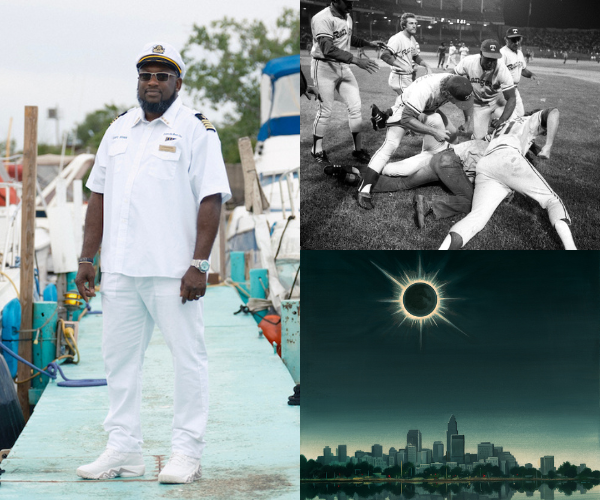The Great Divide
by Erick Trickey | Nov. 19, 2010 | 5:00 AM
Cleveland doesn't build statues for former mayors anymore. But U.S. Sen. George Voinovich, who retires at year's end, doesn't need one. The city has already built monuments to him all across downtown: the Rock Hall, Key Tower, Progressive Field. And he's left his own landmark on our political geography. Our entire map has been rearranged around it.
Every argument in modern Cleveland politics — every one — goes back to Voinovich's 10 years as mayor. When he uttered the phrase "public-private partnership" at a 1980 Growth Association meeting, he fathered a new civic discourse that transformed our economic strategies, our downtown and our national image.
That is Voinovich's legacy in Cleveland.
The Comeback City advocates say Voinovich partnered with business to revive the town. Populists call the comeback rhetoric hollow, noting that the city is still in poverty and losing population, and millions of public dollars have gone to downtown landmarks instead of schools. The vein runs from default to the Rock Hall from Gateway to the Medical Mart. The Cleveland question isn't, Are you conservative or liberal? It's, Do you think about the city the way Voinovich did?
"I want to build a great city where Cleveland used to be," Voinovich declared in his 1979 campaign to unseat Dennis Kucinich. Cleveland had defaulted on its loans thanks to Kucinich's fight with the banks over Muny Light. The Boy Mayor was no New Age peace apostle then. To him, governing was war. Kucinich made big business his mustache-twirling villain, knowing angry populism played well in beaten-down, working-class Cleveland.
So Voinovich sold his new idea with savvy half-populist rhetoric.
"Big business is going to have to live up to its responsibility when I'm elected," he said. "These people are going to have to help this town if they want to save it."
Visiting the Growth Association in January 1980, the new mayor argued for a grand coalition between government and business to encourage development.
"If people are skeptical of public-private partnership," he declared, "let us demonstrate to them, and the entire country, that it is just this kind of partnership that turned things around for Cleveland."
A task force of 89 business executives formed to help make the government more efficient and dig it out of its financial hole. Voinovich negotiated with the banks and refinanced the city's debt, and Cleveland escaped default by year's end.
Next, Voinovich strove to attract visitors to the city, improve its national image and put an end to the Cleveland jokes. In January 1986, the mayor led a team of Clevelanders to New York to ask the Rock and Roll Hall of Fame board to locate its museum here. Four months later, Cleveland won the prize. With the Rock Hall, Voinovich's "public-private partnership" mantra came to mean more than broad cooperation. It also meant development projects masterminded by government, business and nonprofit leaders and paid for with a mix of private funds and tax money.
A building boom broke out at Public Square: Key Tower, downtown's new tallest building, and a new Marriott rose to the north while the renovated Terminal Tower became Tower City Center, complete with a new Ritz-Carlton. To help build them, Voinovich had demolished a Kucinich-era taboo and granted the new developments tax breaks.
Populists rang alarm bells, arguing that tax abatements — and the diversion of tax revenue from Tower City to help build the Rock Hall — gave away money that might have gone to governments and schools.
Voinovich left City Hall in 1989 to run for governor, but he returned to Cleveland months later to join the partners' and populists' greatest battle, Cuyahoga County's vote on the Gateway project. At a podium crowded with TV and radio mics, Voinovich, new mayor Mike White and county commissioner Tim Hagan implored voters to approve a new tax on cigarettes and alcohol to pay for Progressive Field and Quicken Loans Arena.
The political risk loomed as large as the cavernous old Municipal Stadium. Opposition to raising taxes for the Indians and Cavaliers was huge. Gateway only passed with 52 percent of the vote.
Even 20 years later, just say the word "Gateway," and many in town will froth about corporate welfare, sweetheart leases, overblown promises of new jobs, cost overruns and public debt. Others will defend the need to keep the Indians in town, lure the Cavs back from Richfield and make downtown an entertainment and tourist destination.
So the symbolism of that moment, when Voinovich, White and Hagan stood together, is even more apparent now. It reveals the true fault line of modern Cleveland politics: not black and white, not Democrat or Republican, but whether you agreed with Voinovich's vision for Cleveland or not.
In the '90s, Voinovich often returned to town for ribbon-cuttings to back up his allies. He celebrated the new Great Lakes Science Center and rebuilt PlayhouseSquare as model public-private partnerships. But after Voinovich headed to Washington and White retired to his alpaca farm, Cleveland's public-private partnership decayed, falling back more and more on its greatest flaw: making decisions in back rooms, not public forums.
The low point came in 2003, when business leaders launched a poorly conceived push for a new convention center that fizzled before it ever made it to the ballot. Corporate leaders, furious that Jane Campbell pulled the plug on a tax increase for the project, helped drive her from office two years later.
By 2007, when the county and MMPI proposed the Medical Mart, its motley crew of populist opponents often failed to weigh the risks and promise of the venture itself. Instead, they raged against the very idea that government should ever share tax money with a business. They slammed Hagan and Jimmy Dimora for their rushed, closed-door decision to raise the sales tax and threw Gateway's cost overruns back at Hagan, 17 years after the fact.
The critics had their merits: They asked good questions about democracy and transparency. They probably stiffened the county negotiators' spines, pressing them to extract stronger protections against cost overruns. But the populists couldn't see something that Voinovich always saw: Cleveland's glassy, half-empty downtown could be all empty.
"We should try to use our existing economic resources to channel future growth and development into our area," Voinovich told the Growth Association in 1980. "Chronic unemployment, the flight of business from the city and the resultant erosion of our municipal tax base must be stopped."
It all sounds like our woes in 2010 — except now, the economic changes that battered Cleveland itself in 1980 have wounded all of Northeast Ohio. Pan back on the map, and the resurgent downtown of the '80s and '90s looks like neither a success nor a failure, but a rear-guard action against sprawl and Rust Belt decline.
"At this stage in my life, I grieve for my city and my county," Voinovich said last year when he endorsed Issue 6, Cuyahoga County's new charter. "The citizens of this county know the ship's sinking." When voters passed the charter, he celebrated, saying, "Another vessel is in place to carry this county forward."
A two-way partnership isn't nearly enough to counter all the forces wearing down Northeast Ohio's economy. So a new generation of leaders, such as Cleveland Mayor Frank Jackson and county executive-elect Ed FitzGerald, are talking about new ways for cities and suburbs to cooperate, from pledging not to use tax breaks to lure companies out of neighboring towns to sharing increased tax revenue from new businesses.
Meanwhile, the county charter calls for FitzGerald and Jackson to sit down with suburban leaders and representatives of labor, nonprofits and business next year to develop a new economic strategy for the region.
Voinovich may be retiring, but his philosophy of partnership has become so ingrained in Greater Cleveland's thinking, it's written right into our new government.
Trending
-
1
-
2
-
3
-
4
-
5










